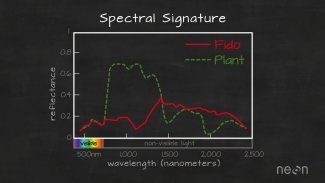Mapping the invisible: the power of spectral remote sensing
July 14, 2015
The evolution of high-resolution cameras and image spectrometry is changing the landscape of ecology.
Different objects reflect, absorb and transmit light differently, including light that is visible or not visible to the human eye. Cameras and image spectrometers both measure reflected light energy to capture images. However, cameras record visible light in three bands that fall within the Red-Green-Blue (RGB) spectrum, while imaging spectrometers break the electromagnetic spectrum into many bands that support classification of objects on the earth’s surface by their spectral properties. When mounted on airplanes and satellites, these instruments help scientists measure changes to the earth’s surface over large areas.
This NEON Data Skills video was developed in collaboration with:
- Kyla Dahlin, Michigan State University
- Shawn Serbin, Brookhaven National Laboratory
- Keely Roth, University of California, Davis post-doctoral scholar
- Laura Chasmer, University of Lethbridge
Capturing changes in vegetation cover
Plants reflect up to 60% more light in the near infrared part of the electromagnetic spectrum than in the green portion of the spectrum. Using imaging spectrometers to capture the invisible part of the spectrum, when converted into a spectral signature and combined with RBG imagery, provide spatial data that can shed light on changes to vegetation composition and cover.

How does NEON use spectral remote sensing?
NEON conducts airborne observation flights annually over terrestrial and aquatic sites; the Airborne Observation Platform (AOP) includes an imaging spectrometer, a light detection and ranging (LiDAR) instrument and a high-resolution RGB camera. Spectral remote sensing data, when integrated with lidar and field observations is used to measure, understand and forecast ecological changes in:
- Vegetation cover, composition and dominant vegetation type
- Vegetation structure including height, density and Leaf Area Index (LAI)
- Canopy chemistry
- Vegetation health
Learn more about NEON’s Airborne Observation Platform collection methods.
More science videos and Data Skills resources
Check out other NEON science videos and subscribe to our YouTube channel to receive updates about new videos. For more on spectral remote sensing, check out the Data Skills portal for data skills tutorials on a variety of topics including spectral remote sensing.
